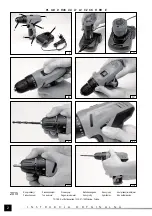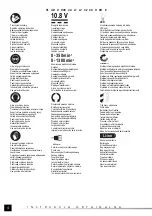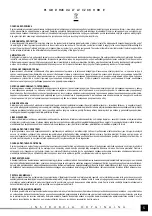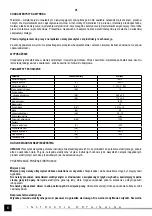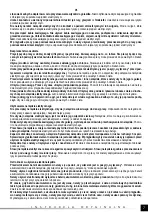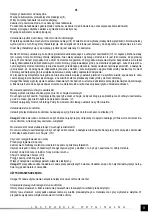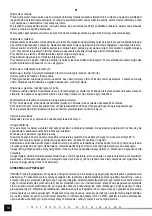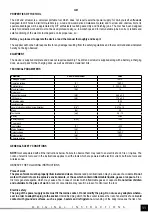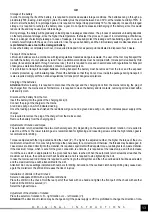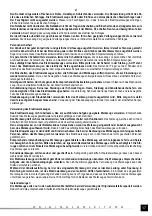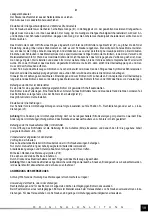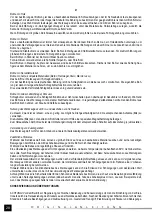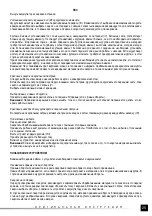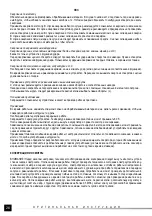
12
GB
O R I G I N A L I N S T R U C T I O N S
electric shock.
Do not expose electric tools to precipitation or humidity.
Water and humidity which gets into the electric tool
increases the risk of an electric shock.
Do not overload the power supply cable. Do not use the power supply cable in order
to carry the tool or to connect and disconnect the plug from the mains socket. Avoid contact of the power supply cable
with heat, oils, sharp tools and moving elements.
Damage to the power supply cable increases the risk of an electric shock.
In case work is realised outside closed areas, it is necessary to use extension cords designed for applications outside
closed areas.
Using a correct extension cord permits to reduce the risk of an electric shock.
Personal safety
Commence work in good physical and psychological conditions. Pay attention to what you do. Do not work if you are
tired or under effects of medicines or alcohol.
Even a moment’s inattention during work may lead to serious injuries.
Always
use individual means of protection. Always wear goggles.
Using individual means of protection, such as dust-masks, protec-
tive shoes, helmets and hearing protections permits to reduce the risk of serious injuries.
Avoid accidental activation of the
tool. Make sure the switch is in the OFF position, before you connect the tool to the mains.
Holding the tool with a finger
on the switch or connecting an electric tool when the switch is in the ON position may lead to serious injuries.
Before you turn an
electric tool on remove all the spanners and other tools, which have been used for adjustments.
A spanner left on rotating
elements of the tool may lead to serious injuries.
Keep your balance. Maintain an appropriate position.
It will permit to control
the electric tool in case of unpredicted situations during its operation.
Use protective clothes. Do not wear loose clothes or
jewellery. Keep your hair, clothes and gloves away from moving elements of the electric tool.
Loose clothes, jewellery or
long hair may get caught on moving elements of the tool.
Use dust extractors or dust containers, if the tool is equipped with
any. Make sure they are properly connected.
Using of dust extractors permits to reduce the risk of serious injuries.
Safety precautions while using the electric tool
Before the battery is installed, make sure the switch is off. Installation of the battery when the switch is on may lead to accidents.
Use solely the charger recommended by the manufacturer. Using a charger designed for another type of battery may be a cause
of fire.
The electric tool must be operated exclusively with the battery indicated by the manufacturer. Using another battery may be a
cause of fire or injuries.
When the battery is not used, it must be stored away from such metal objects as paper clips, coins, nails, screws or other small
metal elements, which might short-circuit the terminals
.
Short-circuited terminals of the battery may cause burns or fire.
Under adverse circumstances liquid may leak from the battery; avoid any contact. In case of accidental contact with the liquid,
rinse it with water. In case of eye contact, seek medical. The liquid leaking from the battery may cause irritation or burns.
During work when the tool may touch a hidden live conductor, the electric tool must be held by insulated handles. The installed bit
in case of contact with a live conductor may conduct electricity to the metal elements of the tool, which may cause electric shock
to the operator.
Repairs
Have the tool repaired solely by authorised workshops, where original spare parts are used
. This will ensure the adequate
safety of operation of the electric tool.
PREPARATION FOR WORK
ATTENTION! All the operations mentioned in this point must be realised with the power supply off.
- the battery must be disconnected from the tool!
Safety recommendations for battery loading
Attention!
Before loading may start make sure the body of the charger, the cable and the plug are not broken or damaged. It
is prohibited to use a damaged loading dock and charger! For the purpose of loading batteries only the charging dock and the
charger provided may be used. Using another charger may be a cause of fire or damage the tool. Batteries may be charged only
in a dry room, protected from unauthorised persons, particularly children. Do not use the charging dock and the charger without
permanent supervision of an adult! If it is necessary to leave the room where loading is taking place, it is required to disconnect the
charger from the mains, removing the charger from the mains socket. In case when smoke comes out of the charger, or a strange
smell is emitted, etc., it is required to immediately remove the plug of the charger from the mains socket!
The drill and automatic return screwdriver is provided with an unloaded battery, so before work may commence, it is required
to charge it following the procedure below, using the charger and charging dock provided. Li-ION batteries do not show the so
called “memory effect”, so it is allowed to charge them at any moment. However, it is recommended to discharge them during
normal work, and then load them to their full capacity. If due to the nature of the task it is not possible to do so each time, then it
is required to do it at least from time to time. Under no circumstances is it allowed to discharge the batteries short-circuiting the
electrodes, since this would cause irreversible damage! It is also prohibited to check the load of the batteries, short-circuiting the
electrodes for sparking.


